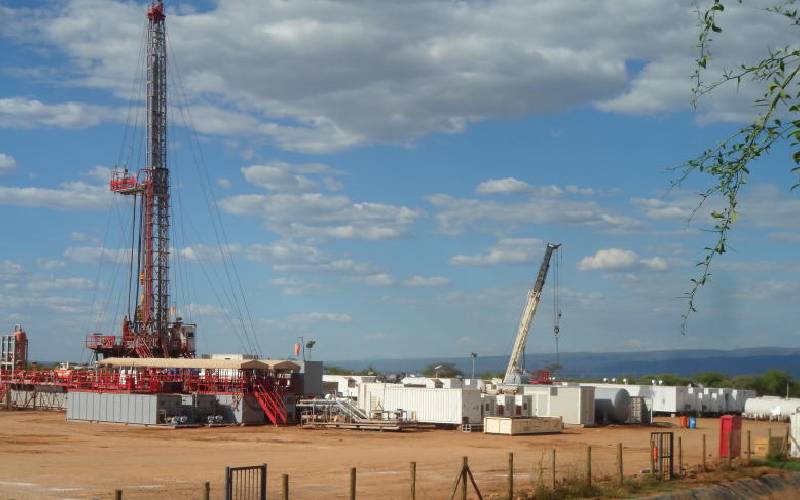
The early oil pilot scheme that was expected to see Kenya start producing and exporting crude oil on a trial basis next month might face delays.
This follows the lengthy process of selecting the companies that will move crude oil from Turkana to Mombasa by the Ministry of Energy and joint venture partners in the Lokichar oil project.
The Government together with the joint venture companies – Tullow Oil, Africa Oil and Maersk Oil – had hoped to name the suppliers of trucks and insulated containers (tanktainers) that would move the oil to Mombasa by end of March.
This was to enable them adequately prepare and start moving the crude to Mombasa by last month. But more than a month later, the logistics company as well as the supplier of specialised tanktaniners that will carry the commodity are yet to be named. This casts doubt as to whether the country will meet its deadline of shipping the first oil cargo by end of June.
Under the Early Oil Pilot Scheme (EOPS), Tullow Oil and its partners will produce 2,000 barrels of a day from the Lokichar oil fields and move them to Mombasa.
They will then be stored at the Kenya Petroleum Refineries Ltd, where some of the tanks are being prepped for receipt of the crude and exported when the oil gets to required levels and a buyer found.
The delay in procuring suppliers of tanks and the insulated containers is despite strict deadlines that Ministry of Energy officials have in the past said they are working with.
“We are working with strict timelines and should be able to stick to June as the date for the export our first batch,” said Keter in March when he signed EOPS agreements with the joint venture partners giving them the greenlight to go on with the pilot project.
Pilot project
A Tullow Oil official said two local firms have been selected and are about to be awarded contracts for the provision of the tanktainers as well as the provision of trucks that would deliver the oil to Mombasa.
“There are 30 tanktainers, with 20 of them being in excellent conditions while the other 10 are currently undergoing renovation to bring them up to standard. They should be signing a contract in the course of this or next week,” said the official.
The official noted said the delay so far is unlikely to affect the pilot project considering that the initial barrels of oil are ready for transportation.
Tullow has so far produced 60,000 barrels of oil from some of the wells in the South Lokichar, which will form the first cargo that Kenya will start exporting at around June.
In an operational update issued last week, Tullow said it had made ample preparations for the pilot programme and would start production of 2,000 barrels a day at around October this year.
Stay informed. Subscribe to our newsletter
“The Early Oil Pilot Scheme (EOPS) Agreement between the Kenya joint venture and the Government of Kenya was signed on 14 March 2017 allowing all EOPS upstream contracts to be awarded,” said Tullow in the update.
“The first stage of the EOPS will be the evacuation of the stored crude oil, which was produced during extended well testing in 2015, to Mombasa by road. This will be followed by EOPS production of 2,000 barrels of oil per day in the fourth quarter of 2017.”
“The EOPS will provide important information which will assist in full field development planning.”
The early oil programme is expected to take place between now and 2020. It is expected to gauge the reaction of international markets to Kenya’s crude. After 2020, the Government expects to have a pipeline in place between Turkana and Lamu that will then be used to export larger volumes of crude.
Already, progress has been made, including studies and other preparatory work geared towards the start of Front End Engineering Design (FEED), which is expected to start in the second half of this year.
“In parallel to the upstream development work, the Kenya Joint Venture and the Government of Kenya continue to progress the export pipeline,” said Tullow.
“Commercial and finance studies and preparations are under way for the Environmental and Social Impact Assessment and FEED which are also planned for the second half of this year.”
 The Standard Group Plc is a
multi-media organization with investments in media platforms spanning newspaper
print operations, television, radio broadcasting, digital and online services. The
Standard Group is recognized as a leading multi-media house in Kenya with a key
influence in matters of national and international interest.
The Standard Group Plc is a
multi-media organization with investments in media platforms spanning newspaper
print operations, television, radio broadcasting, digital and online services. The
Standard Group is recognized as a leading multi-media house in Kenya with a key
influence in matters of national and international interest.
 The Standard Group Plc is a
multi-media organization with investments in media platforms spanning newspaper
print operations, television, radio broadcasting, digital and online services. The
Standard Group is recognized as a leading multi-media house in Kenya with a key
influence in matters of national and international interest.
The Standard Group Plc is a
multi-media organization with investments in media platforms spanning newspaper
print operations, television, radio broadcasting, digital and online services. The
Standard Group is recognized as a leading multi-media house in Kenya with a key
influence in matters of national and international interest.









